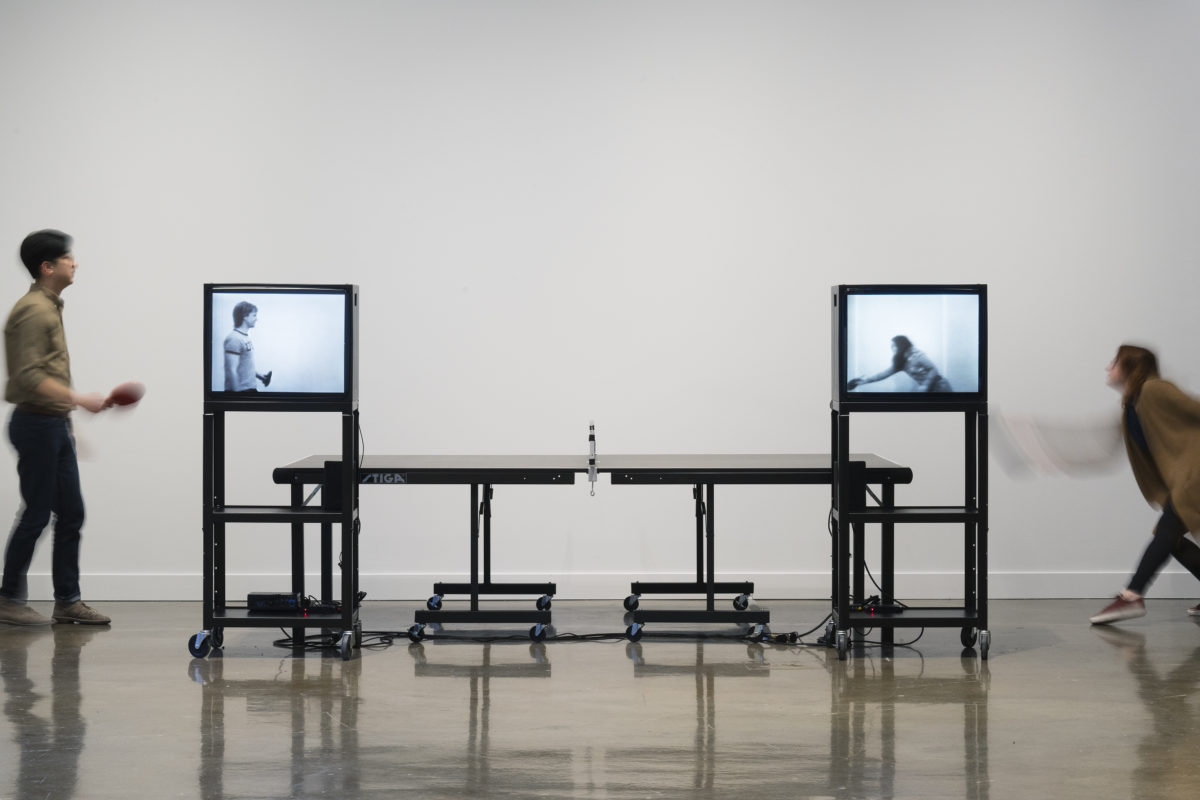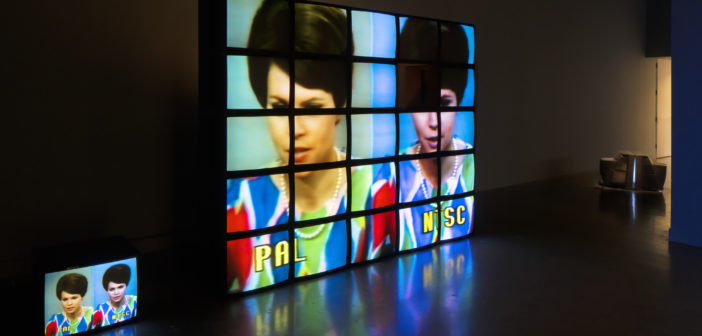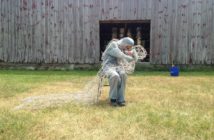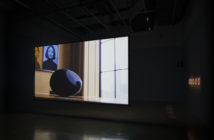The rippling surface of water in a small steel structure catches and reflects fragments of light and color, casting it onto the surrounding walls and ceiling. These reflections are the result of three video monitors installed in a row several feet above the metal trough, their screens parallel to the water’s surface. The videos, which show the artist Shigeko Kubota swimming through a body of water, are silent, so all that can be heard is the faint hum from the water pump itself. This work, titled River (1979-81), is the manifestation of Kubota’s concept of “liquid reality,” in which she poses questions such as “What is real?” and “Is it possible to exist in multiple states at once?”, challenging our perception of a linear or static state of existence. In River, the water abstracts and distorts the original feed, creating a new version of reality for the viewer.
Kubota’s installation is one of twelve immersive works included in Before Projection: Video Sculpture 1974-1995, now on view at the Hayden and Reference Galleries of the MIT List Visual Arts Center. The exhibition features a survey of the dynamic approaches to video sculpture exhibited by artists working during this period, before the rise of new technologies and screening methods pushed video artists towards projected imagery. The works created during these decades were exploratory of television as a medium, and true to the source of the inspiration. The artists were drawn to the sculptural quality of the television—a large box that could display images. The screen was the site for various experiments afforded by television’s ability to show a sequence of one or multiple still images, a moving video work, and more. Artists such as Nam June Paik often manipulated these images with magnets and other forces applied externally to the television frame. The influence of their work on the development of video art can still be felt today, and the lasting impression of their vision persists despite being overshadowed by later approaches to the medium.

Shigeko Kubota, "River," 1979-81, Videotape, color, silent; three monitors, stainless–steel container, mirrors, pump, water, Courtesy Shigeko Kubota Video Art Foundation, New York, Installation view "Before Projection: Video Sculpture 1974-1995," MIT List Visual Arts Center, 2018, Photo: Peter Harris Studio
Before Projection was organized by Director of Exhibitions and Curator Henriette Huldisch, who notes the importance of this predominately underrecognized period in art history, and aims to highlight its impact on contemporary art. Regardless of the lack of critical writing that exists about these works, it cannot be denied that early video sculpture influenced the trajectory of video’s use in art and expanded its influence to other mediums, such as sculpture and installation. An objective true to Huldisch’s focus was to showcase the diverse works of numerous artists both widely known and underrecognized—but immensely important—international artists, including Shigeko Kubota, Tony Oursler, Dara Birnbaum, Takahiko Iimura, Nam June Paik, Adrian Piper, Ernst Caramelle and Diana Thater, among others.
As a cultural reflection, these works speak volumes of the era. Prior to the internet, television was the population’s go-to source for news, entertainment, and media broadly. The artists on view in Before Projection adapted this communication device, using the object of the television to create works of art that conveyed messages of their own. They saw television as an unnatural insertion of media in our daily life that had gradually become normal, and their work challenged how the public had grown to engage with it.
Adrian Piper’s Out of the Corner (1990), for instance, is a work that confronts the ideology inherent to racist perspectives that are relentlessly present in the United States. Piper asserts that, despite appearances (she herself is often mistaken as white), the majority of the population is in fact multiracial. In Out of the Corner, she questions how this might affect racial politics in America were more aware of this fact. The work consists of seventeen monitors resting on separate pedestals, forming a grouping of screens that display the faces of men and women who appear to be white, but all repeat the same line describing how their black ancestors were raped by white slave owners. “If you are an American,” they recite, “some of yours [ancestors]probably were [black]too.” In front of each pedestal lies a chair turned on its side, legs pointed toward the viewer. This is evocative of the message Piper is communicating: a turning of historical narratives on their head, and a challenge to the viewer to re-examine her prejudices.
Where Piper’s installation relays information and requires reflection, Ernst Caramelle’s Video-Ping-Pong (1974) encourages viewer engagement and participation. The piece consists of two videos playing on two separate monitors, each installed on a metal shelving unit. A recording of a table tennis match plays on the screens, one positioned at either end of a physical ping pong table installed in the gallery. The viewer can watch the exchange, the back and forth of the ping pong game between the two televisions. Additionally, viewers can activate the piece through the incorporation of their own bodies as material; they are invited to pick up a paddle and start a game of their own, mirroring the action on the monitors. This interactive installation is playful and creates a minute social contract with the audience members as they become an active part of the work itself.

Ernst Caramelle, "Video-Ping-Pong," 1974, Two-channel, video installation, 2 monitors, 2 media players, metal shelves, ping pong table, paddles, and ping pong balls
Reconstruction tale, metal-racks and technical equipment: Ernst Caramelle with Generali Foundation, 2000, Courtesy Generali Foundation Collection, Permanent Loan to the Mueum der Moderne Salzburg, Installation view "Before Projection: Video Sculpture 1974-1995," MIT List Visual Arts Center, 2018, Photo: Peter Harris Studio
Despite the differences in their work, Caramelle, Piper, and Kubota all appear to be in dialogue, as they each challenge the boundaries of the television frame, pushing their work beyond it. Along with the other artists on view in Before Projection, their works stem from the understanding of the television as a circulation device—one that offers viewers access to both the harsh reality of current affairs and an escape into alternative worlds through mindless entertainment.
Before Projection: Video Sculpture 1974-1995 opened on February 8 and will remain on view through April 15, 2018. The MIT List Visual Arts Center is located at 20 Ames Street, Bldg. E15-109 Cambridge, MA 02139. For more information including hours, special events, accessibility, and more, please visit: https://listart.mit.edu/exhibitions/projection-video-sculpture-1974-1995




